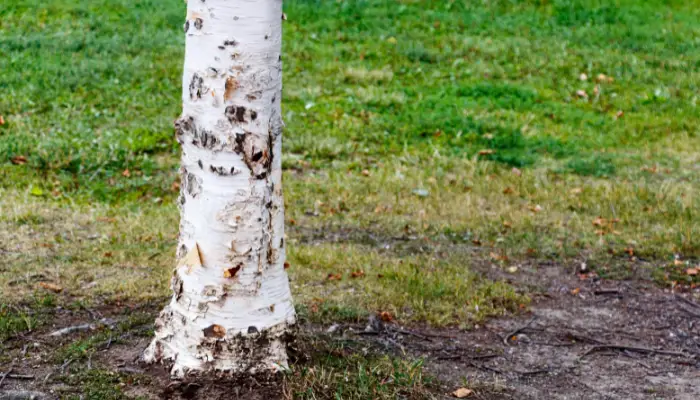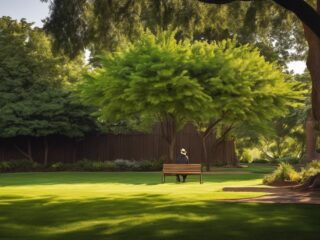Nature is a marvel of resilience and regeneration, with trees standing as silent witnesses to the ever-changing cycles of life.
Among the many fascinating aspects of tree anatomy, the bark plays a crucial role in protecting the inner layers of the tree from external threats.
But what happens when a tree loses its bark?
Will tree bark grow back?
We look into the facts behind bark regeneration, uncovering the nature of a tree’s healing process.
The Importance of Tree Bark
Did you know that tree bark serves as a multifunctional shield, safeguarding the tree from various environmental factors, including pests, diseases, and extreme weather conditions?
Here is why tree bark is essential:
Protection Against Pests
Tree bark acts as a physical barrier that prevents insects and pests from infiltrating the delicate tissues beneath. Many tree-dwelling insects lay their eggs in the bark, making it a crucial line of defense against infestations.
Disease Resistance
The bark contains compounds that help trees resist diseases. It acts as a formidable barrier against fungal infections and bacterial invasions, maintaining the overall health of the tree.
Weather Resilience
The outermost layer of bark provides insulation, protecting the tree from temperature extremes, wind, and sunlight. This insulation is crucial for the tree’s ability to maintain a stable internal environment.
Will Tree Bark Grow Back?
Yes, tree bark has the remarkable ability to grow back under certain conditions. The process of bark regeneration is a fascinating aspect of a tree’s resilience and survival mechanisms.
When a tree experiences damage to its bark, whether due to natural causes or human interference, it initiates a series of biological processes to heal and restore the protective outer layer.

Will Tree Bark Grow Back?
Tree the Bark Structure

To comprehend the regeneration process, it’s vital to grasp the structure of tree bark.
Bark is not a single entity but a complex combination of tissues that serve distinct purposes.
The primary components of tree bark include the outer bark, inner bark, cambium layer, and phloem.
- Outer Bark: This is the protective outer layer that shields the tree from external elements. It is comprised of dead cells, and its thickness varies among tree species.
- Inner Bark (Phloem): The inner bark, also known as phloem, is a living tissue responsible for transporting nutrients produced by photosynthesis from the leaves to the rest of the tree.
- Cambium Layer: Situated between the inner bark and the wood, the cambium layer is a thin, actively dividing tissue that gives rise to both inner bark and wood cells.
- Phloem: The phloem is a vital component of the inner bark responsible for the transportation of sugars and other organic nutrients produced by the leaves.
Tree Bark Regenerative Process
When a tree loses its bark due to external damage, whether from natural causes or human intervention, the regeneration process begins. The tree’s ability to regenerate bark depends on various factors, including the severity of the damage, the tree species, and its age.
Callus Formation
In response to bark loss, trees initiate a callus formation process. Callus tissue consists of undifferentiated cells that proliferate rapidly, forming a protective barrier over the exposed area. This initial step is crucial for preventing infections and minimizing the risk of further damage.
Cork Cambium Activation
The cork cambium, a layer of dividing cells within the callus tissue, becomes activated. These cells differentiate into cork cells, which contribute to the development of the new outer bark. This process is essential for restoring the protective barrier that was compromised.
Phloem and Cambium Recovery
Simultaneously, the tree allocates resources to regenerate the inner bark (phloem) and the cambium layer. This ensures the re-establishment of the vascular system necessary for nutrient transport and overall tree health.
Secondary Growth
Over time, the newly formed bark undergoes secondary growth, increasing in thickness and strength. This gradual maturation process enhances the tree’s resilience and reinforces its ability to withstand future challenges.
Factors Influencing Bark Regeneration
While trees exhibit a remarkable capacity for bark regeneration, several factors can influence the success of this process.
- Tree Species: Different tree species have varying levels of regenerative capacity. Some species are highly adept at recovering from bark damage, while others may struggle to regenerate fully.
- Tree Age: The age of the tree plays a significant role in bark regeneration. Younger trees generally have a higher regenerative potential compared to older, more mature trees. The efficiency of callus formation and cell differentiation tends to diminish with age.
- Environmental Conditions: Environmental factors such as climate, soil quality, and overall ecosystem health can impact a tree’s ability to regenerate bark. Trees in optimal environmental conditions are likely to recover more successfully.
- Severity of Damage: The extent of the damage inflicted on the tree’s bark is a critical factor. Trees can recover from minor injuries more effectively than from severe wounds that penetrate deep into the inner layers.
Conclusion
In conclusion, the question “Will tree bark grow back?”
unveils a captivating journey into the intricate world of tree biology and regeneration.
Because of their inherent toughness and adaptive systems, trees can mend and recover from damage to their bark.
The process of regeneration includes the production of calluses, activation of the cork cambium, recovery of the phloem and cambium, and secondary growth.
The ability of trees to regenerate bark highlights the interconnectedness of all living things and the enduring power of nature’s cycles.
Therefore, the next time you come across a tree with a wounded exterior, stop and marvel at the silent strength and tenacity that allow it to grow back, embodying the perpetual cycle of life and renewal in the natural world.
This understanding of trees’ resilience helps us as stewards of the environment better understand the delicate balance within ecosystems.
Here’s a FAQ section related to the topic of tree bark regeneration below:
Q1: Will all trees regenerate their bark?
A1: While many tree species have the ability to regenerate bark, the extent and efficiency of regeneration can vary between species. Some trees exhibit robust regenerative capabilities, while others may face challenges in fully restoring their bark.
Q2: How long does it take for tree bark to grow back?
A2: The time it takes for tree bark to grow back depends on factors such as the tree species, environmental conditions, and the severity of the damage. In general, the initial stages of callus formation can occur relatively quickly, but complete regeneration may take several years.
Q3: Can a tree survive if it loses a significant amount of bark?
A3: The survival of a tree after losing bark depends on the extent of the damage and the tree’s overall health. Trees are resilient, and they can survive and continue to grow even after significant bark loss. However, severe damage may compromise the tree’s ability to transport nutrients, making its recovery more challenging.
Q4: Can humans assist in the bark regeneration process?
A4: While nature has its regenerative processes, humans can aid in the recovery of damaged trees. Practices such as careful pruning, proper wound treatment, and maintaining a healthy environment around the tree can support and expedite the bark regeneration process.
Q5: Are there any tree species that struggle with bark regeneration?
A5: While most trees have evolved to regenerate bark, some species may face challenges, especially in stressful environmental conditions or if they are already weakened by diseases or pests. Understanding the specific needs of each tree species is crucial for successful regeneration.
Q6: How does environmental pollution affect bark regeneration?
A6: Environmental pollution, including air and soil pollutants, can negatively impact a tree’s overall health and its ability to regenerate bark. Pollution stress may weaken trees, making them more susceptible to diseases and hindering the regeneration process.
Q7: Can trees regenerate bark indefinitely?
A7: While trees have a remarkable ability to regenerate bark, there are limits to this process. Factors such as age, overall health, and the frequency and severity of damage can influence a tree’s long-term regenerative capacity.
Q8: Are there any signs that indicate a tree is struggling with bark regeneration?
A8: Signs of a tree struggling with bark regeneration may include slow growth, dieback of branches, and the presence of diseases or pests. Regular inspection of a tree’s overall condition can help identify potential issues with bark regeneration.
Q9: Can trees with damaged bark pose a risk to the environment?
A9: In some cases, trees with compromised bark may be more vulnerable to diseases or pest infestations. It’s essential to monitor such trees to prevent the spread of potential threats to the surrounding environment.
Q10: How can individuals contribute to tree health and bark regeneration?
A10: Individuals can contribute to tree health by avoiding unnecessary damage, providing proper care such as watering and fertilization, and seeking professional advice for tree maintenance. Responsible practices can enhance a tree’s resilience and support its natural regeneration processes.




